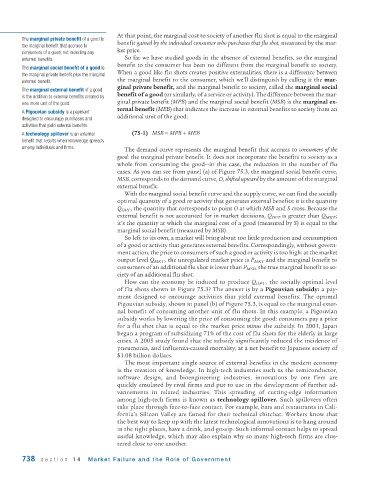Page 780 - Krugmans Economics for AP Text Book_Neat
P. 780
At that point, the marginal cost to society of another flu shot is equal to the marginal
The marginal private benefit of a good is
benefit gained by the individual consumer who purchases that flu shot, measured by the mar-
the marginal benefit that accrues to
ket price.
consumers of a good, not including any
external benefits. So far we have studied goods in the absence of external benefits, so the marginal
benefit to the consumer has been no different from the marginal benefit to society.
The marginal social benefit of a good is
When a good like flu shots creates positive externalities, there is a difference between
the marginal private benefit plus the marginal
external benefit. the marginal benefit to the consumer, which we’ll distinguish by calling it the mar-
ginal private benefit, and the marginal benefit to society, called the marginal social
The marginal external benefit of a good
benefit of a good (or similarly, of a service or activity). The difference between the mar-
is the addition to external benefits created by
one more unit of the good. ginal private benefit (MPB) and the marginal social benefit (MSB) is the marginal ex-
ternal benefit (MEB) that indicates the increase in external benefits to society from an
A Pigouvian subsidy is a payment
additional unit of the good:
designed to encourage purchases and
activities that yield external benefits.
A technology spillover is an external (75-1) MSB = MPB + MEB
benefit that results when knowledge spreads
among individuals and firms.
The demand curve represents the marginal benefit that accrues to consumers of the
good: the marginal private benefit. It does not incorporate the benefits to society as a
whole from consuming the good—in this case, the reduction in the number of flu
cases. As you can see from panel (a) of Figure 75.3, the marginal social benefit curve,
MSB, corresponds to the demand curve, D, shifted upward by the amount of the marginal
external benefit.
With the marginal social benefit curve and the supply curve, we can find the socially
optimal quantity of a good or activity that generates external benefits: it is the quantity
Q OPT , the quantity that corresponds to point O at which MSB and S cross. Because the
external benefit is not accounted for in market decisions, Q OPT is greater than Q MKT ;
it’s the quantity at which the marginal cost of a good (measured by S) is equal to the
marginal social benefit (measured by MSB).
So left to its own, a market will bring about too little production and consumption
of a good or activity that generates external benefits. Correspondingly, without govern-
ment action, the price to consumers of such a good or activity is too high: at the market
output level Q MKT , the unregulated market price is P MKT and the marginal benefit to
consumers of an additional flu shot is lower than P MSB , the true marginal benefit to so-
ciety of an additional flu shot.
How can the economy be induced to produce Q OPT , the socially optimal level
of flu shots shown in Figure 75.3? The answer is by a Pigouvian subsidy: a pay-
ment designed to encourage activities that yield external benefits. The optimal
Pigouvian subsidy, shown in panel (b) of Figure 75.3, is equal to the marginal exter-
nal benefit of consuming another unit of flu shots. In this example, a Pigouvian
subsidy works by lowering the price of consuming the good: consumers pay a price
for a flu shot that is equal to the market price minus the subsidy. In 2001, Japan
began a program of subsidizing 71% of the cost of flu shots for the elderly in large
cities. A 2005 study found that the subsidy significantly reduced the incidence of
pneumonia, and influenza-caused mortality, at a net benefit to Japanese society of
$1.08 billion dollars.
The most important single source of external benefits in the modern economy
is the creation of knowledge. In high-tech industries such as the semiconductor,
software design, and bio engineering industries, innovations by one firm are
quickly emulated by rival firms and put to use in the development of further ad-
vancements in related industries. This spreading of cutting-edge information
among high-tech firms is known as technology spillover. Such spillovers often
take place through face-to-face contact. For example, bars and restaurants in Cali-
fornia’s Silicon Valley are famed for their technical chitchat. Workers know that
the best way to keep up with the latest technological innovations is to hang around
in the right places, have a drink, and gossip. Such informal contact helps to spread
useful knowledge, which may also explain why so many high-tech firms are clus-
tered close to one another.
738 section 14 Market Failure and the Role of Gover nment

